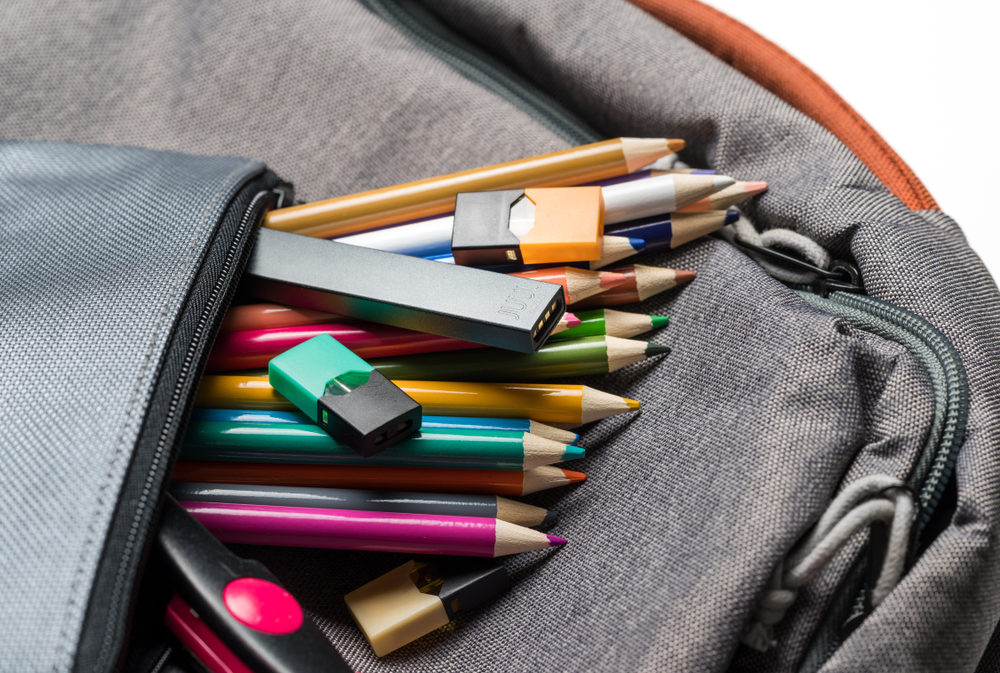1-in-5 High Schoolers Still Vape, CDC Study Shows

Although substantial efforts have helped control the teen vaping epidemic over the last year, the findings of a new study suggest nearly one out of every five high school students currently vape, with many having switched to menthol products following recent bans on flavored cartridges.
The U.S. Centers for Disease Control and Prevention (CDC) released the findings in the latest issue of the agency’s Morbidity and Mortality Weekly Report, finding fewer teens vaping now than in 2019, but there are likely still more than 3.6 million high school and middle school students who are using e-cigarettes.
Roughly one out of five high schoolers and one in 20 middle schoolers are ongoing e-cigarette users, according to the findings. Most of those teens are using pre-filled pods, such as JUUL, and are still vaping with fruit flavors or menthol, which have been blamed for driving a rise in use of e-cigarettes among the nations use in the recent years.

Did You Know?
Millions of Philips CPAP Machines Recalled
Philips DreamStation, CPAP and BiPAP machines sold in recent years may pose a risk of cancer, lung damage and other injuries.
Learn MoreThe CDC and the Food and Drug Administration (FDA) analyzed nationally representative data from the 2020 National Youth Tobacco Survey, a cross-sectional school-based self-administered survey of U.S. middle school and high school students conducted during January 16 to March 16.
In 2020, roughly 20% of high school students use e-cigarettes and 5% of middle school students say they vape. Comparatively, in 2019, 27% of high school students vaped and 11% of middle school students used e-cigarettes.
Overall, one-fifth of high school users and 10% of middle school users reported using e-cigarettes daily. About 40% of high school students and 20% of middle school students reported using e-cigarettes on 20 or more of the past 30 days surveyed.
The most commonly used devices among high schoolers were pre-filled pods or cartridges, like JUUL brand pods. Nearly 50% of high school-aged vapers and 41% of middle school e-cigarette users used pre-filled vaping cartridges, the most popular of which is JUUL.
JUUL brand pods were designed to deliver higher rates of nicotine than other e-cigarettes, making them more addictive. In fact, critics claim JUUL pods were designed like Marlboro cigarettes and made to be as addictive as smoking.
About 27% of high school students and 15% of middle school students used disposable vapes.
Pre-filled pods, like JUUL, were the most commonly used device in 2019, but the use of disposable e-cigarettes increased more than 1,000% after federal regulators banned fruit flavored cartridge-style vaping devices earlier this year. That ban did not extend to disposable vaping devices.
Among all current teen users, 83% used flavored e-cigarettes, translating to roughly 85% of high school users and 74% of middle school users.
The most popular flavors were fruit flavors. Roughly 73% of high school users or 1.8 million teens use fruit flavored vapes, like strawberry or cherry. About 55% of teens used mint flavors, 37% use menthol, and 36% used candy, dessert or sweet flavored vapes.
Among middle school users, 75% used fruit flavors, 47% used candy or dessert flavors, 46% used mint, and 23% used menthol.
One-half of flavored pre-filled pods used among all age groups were menthol flavored.
Prior research suggests teens vape more when using non-traditional flavored e-cigarettes like fruit or candy flavored e-cigarettes, leading to a lifetime of addiction and increased risk they will smoke tobacco cigarettes later in life.
The CDC researchers say their findings suggest that when fruit flavored vaping pods were banned, many teens just switched to menthol flavors, which are still on the market nationwide, though the report indicates some state and local communities have banned menthol products within their jurisdictions.
“Although use of fruit flavored e-cigarettes was common among users in 2020, findings also suggest prominent menthol e-cigarette use, including among nearly one half of flavored prefilled pod or cartridge users and one quarter of flavored disposable product users,” the CDC researchers concluded. “Comprehensive implementation of evidence-based strategies at the national, state, and local levels, in coordination with FDA regulation, can prevent and reduce youth tobacco product use. Strategies to address factors driving youth e-cigarette use are particularly critical.”
A growing number of JUUL teen nicotine addiction lawsuits have been filed nationwide. Given similar questions of fact and law raised in complaints brought throughout the federal court system, the JUUL litigation has been centralized before U.S. District Judge William H. Orrick III in the U.S. District Court for the Northern District of California, which is where JUUL Labs, Inc.’s San Francisco headquarters are located.
As JUUL addiction lawyers continue to review and file claims in the coming months, the litigation is expected to continue to grow, and is likely to encompass tens of thousands of complaints.
Get more articles like this sent directly to your inbox.
"*" indicates required fields






0 Comments